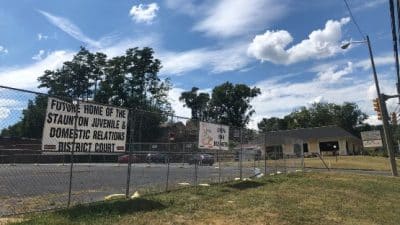Waynesboro reacts to proposed reconfiguration of city elementary schools
Story by Chris Graham
[email protected]

“I’m not in the PTO, I’m not as much in the loop as I’d like to be, but this should have gotten to me somehow. I don’t know, maybe something in Josh’s knapsack,” said Barnes, who learned for the first time a couple of weeks ago that the Waynesboro School Board is considering what would be a radical change in its elementary-education setup.
Under the plan proposed by a committee that included a School Board member, a central-office administrator, elementary-school principals and parents of children from each of the city’s four elementary schools, William Perry Elementary and Berkeley Glenn Elementary would become beginning-tier elementary schools for students in the PreK, kindergarten, first and second grades, with Westwood Hills Elementary and Wenonah Elementary becoming second-tier elementary schools for students in grades three, four and five.

The plan would not affect education at the middle- and high-school levels.
The rollout of the proposal, and the timetable for consideration put forth by the School Board, which has said it will need to make a final decision on the plan by its February meeting if it is to move forward with implementation to take effect in the 2010-2011 school year, “seems to be something that’s being done in a bubble,” said Barnes, and scores of parents across the city whose children’s education options would be impacted by the proposed move agree.
“I’m frustrated with how this was rolled out,” said Terry Short, a member of the Waynesboro Planning Commission and father of two in the Berkeley Glenn Elementary district who has been among the more outspoken critics of the reconfiguration plan.
“They dropped this bomb of what they were going to do two weeks before Christmas. They can talk about surveys being done and how a committee that included parents came up with the recommendations. But most people found out about this two weeks before Christmas. They sent information home one week before Christmas. Right when parents aren’t going to be talking with each other, when there aren’t going to be conversations at the playground or at the PTO meeting. And then coincidentally, let’s have the public hearing the day after school is back in session after the holidays. This isn’t even a blip on the screen, and then we have this rush of activity,” Short said.
***

“We had four proposals that we looked at hard, and this idea kept coming up as making the most sense,” Norcross said.
The top competing alternative would involve a much more basic redrawing of district lines to shift around 30 or so students from the Westwood Hills district to the other three elementary schools. School Superintendent Robin Crowder said he assumed at the outset of the committee’s work on the redistricting matter that “we would just move some streets on the map.”
Even then, of course, “we knew that there would be people who would be upset if we had to move any students,” Crowder said.
An early avenue that was explored looked at moving students who live in the immediate vicinity of Westwood Hills in the nearby Tree Streets to the Berkeley Glenn district where the remaining Tree Streets feed into, for example, but that idea was met with “stiff resistance” from residents of the affected neighborhoods.
As the review continued through October and November, “The question became, Do you want to do redistricting every year, or do you want to put something in place that would help us better use our existing capacities? Because the two largest schools in the city are on the side of the city with the most growth,” Crowder said.
“When the committee got to that point, I think everybody got to the realization that, Oh, my gosh, we’re going to be doing this every two to three years, because we’re going to keep running out of space at Westwood, and we’re going to keep having issues with the quality of programs at Westwood and equity of programs across the school system,” Crowder said.
Short, a transportation planner for the Virginia Department of Transportation, questions the logic behind the assumptions of growth in the West End, pointing to a slowdown in residential real-estate development and population growth dating to the start of the ongoing national economic recession in 2007 that isn’t likely to turn around in the short or medium terms even when the economy rebounds.
“We’re destroying our neighborhood schools, we’re having kids change schools three times by the time they get to middle school, and we’re doing it based on projections of growth that aren’t going to happen. This makes no sense,” Short said.
***
The feedback on the proposal has been “mixed,” according to both Norcross and School Board Chair Jeremy Taylor, whose initial readout on the redistricting is to lean toward supporting it.
“I think there’s a lot of merit to this plan. I’m not going to tell you that I haven’t thought about it and that I’m not starting to lean one way or the other. I see a lot of benefits in the plan as presented. Mainly instructional benefits,” said Taylor, noting the improved use of space and lowered student-teacher ratios that would come particularly at the PreK-2 level.
“What we’re hearing from the people raising questions about this is that they have no objections to the instructional part of this at all. The concerns expressed to me have been mainly along the lines of transportation kinds of issues, complications having to take two elementary-age students to two elementary schools instead of one. We’re not hearing, that I’m aware of, any objection to the instructional benefits that have been associated with this proposal,” Taylor said.
Jeff Fife, a parent representative on the committee, and the father of three, including one, Carson, a kindergartener, who would be moved from Westwood Hills to William Perry for first and second grade before being returned back to Westwood Hills for grades three, four and five, felt the sting of the proposal at home. “My wife said, What are you thinking?” Fife recalled.
“There are some folks out there who are confused and want more information. There are folks who are scared of the unknown. And folks who have grabbed me and said, Hey, I’m affected, my kids will be split, but I see the impact overall on the school system, and I support it,” Fife said.
“If this goes down, I’m going to have three kids five years apart in three schools. But I recognize that’s a personal sacrifice worth doing, because I believe that if the School Board approves our recommendation, the quality of Carson’s experiences and educational opportunities will be enhanced, and overall for the school system, I think it’s a good thing,” Fife said.
And it may be that the plan as proposed is the right direction for Waynesboro, Short concedes. “We don’t question the reality that change might need to happen, or that we need to accommodate the growth that will come to the city in time. What we do question is the need to react the way we are. We need to plan, not react. We’re trying to say, Listen, let’s talk about other communities that have done this or thought about doing it. Basically, let’s give this some thought,” Short said.
Barnes is in a similar place as she tries to make sense of what is going on. “I feel like they’re acting in crisis mode, and there’s not a crisis. This is a really aggressive move. What they’re doing here is pretty dramatic. And I feel they’re doing it too quickly,” Barnes said. “We’re talking parents and teachers and bus drivers. So many people are being affected by this. And we’re doing this all in a few weeks. What do we know about this kind of program? Where has it been implemented? How long have they been doing it so we can get a sense of how it’s working?”
***
Of interest on that point, Taylor is right there with Barnes and Short and others on the observation that the School Board needs to take the time to investigate the proposal thoroughly before coming to a final decision.
“We cannot be asking the community to buy into a paradigm shift, as the administration has called this, without real hands-on, firsthand knowledge,” said Taylor, who proposed a series of visits by School Board members to communities in Virginia that have put into place similar PreK-2 and 3-5 tiered systems that are now on the schedule for the month of January.
“I agree with what a lot of the early opponents are saying. It is a tight time frame. If we thought in the slightest that we were rushing this decision or making it in haste, I don’t think anybody wants to see this decision made in haste. I would say we need to make the decision expeditiously, but based on all the data. And if the board feels that we’re making this decision in haste, we’re simply not going to make it this year,” Taylor said.
Fife would support that move if it were to come about.
“I wouldn’t have any heartburn if this was passed, was canceled, was put aside for a year to allow for additional time for more study. I’m confident in the recommendation and what was accomplished as a committee, but this is a lot to look at in a short period of time,” Fife said.
As to the stakes, well, they’re not all that dramatic.
“You can do that. Now, the people at Westwood would have to understand that the delivery of services would be different. We’ll have classrooms in the art room next year, we’ll have classrooms in the music room, and their program will be somewhat inferior to what other schools are getting,” Crowder said.
“It’s going to be tight at Westwood. The 2010-2011 school year is going to pose some challenges in that particular building. But there are probably things we can do for one year to allow us to revisit this issue if it comes to that point,” Taylor said.
“We’re certainly not going to make this decision in haste simply to beat the deadline to get something in place for next year. However, if we can make a decision based on the facts, and I think we can do that, it’s better to make it than not to make it. Because if we don’t have to incur any additional overcrowding at Westwood, that would be the best solution,” Taylor said.
***
Call to action
WHAT: Waynesboro School Board public hearing on the redistricting proposal
WHEN: Tuesday, Jan. 5, 7 p.m.
WHERE: Waynesboro High School
DETAILS: www.waynesboro.k12.va.us/parents/redistricting.php











